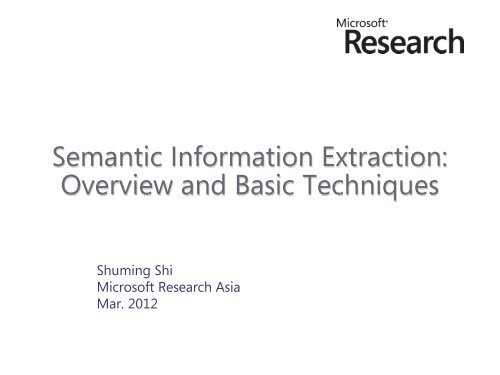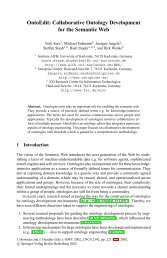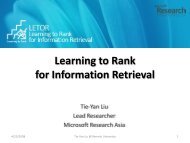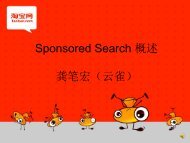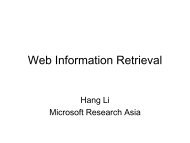Semantic Information Extraction: Overview and Basic Techniques
Semantic Information Extraction: Overview and Basic Techniques
Semantic Information Extraction: Overview and Basic Techniques
You also want an ePaper? Increase the reach of your titles
YUMPU automatically turns print PDFs into web optimized ePapers that Google loves.
<strong>Semantic</strong> <strong>Information</strong> <strong>Extraction</strong>:<br />
<strong>Overview</strong> <strong>and</strong> <strong>Basic</strong> <strong>Techniques</strong><br />
Shuming Shi<br />
Microsoft Research Asia<br />
Mar. 2012
Outline<br />
• <strong>Overview</strong><br />
• <strong>Semantic</strong> class mining<br />
• <strong>Semantic</strong> hierarchy construction<br />
• Mining attribute names <strong>and</strong> values<br />
• General relation extraction<br />
• Demo<br />
• Summary
̵<br />
̵<br />
̵<br />
̵<br />
̵<br />
<strong>Information</strong> <strong>Extraction</strong> (IE)<br />
Definitions<br />
• In Wikipedia<br />
A process to “extract structured information from unstructured<br />
<strong>and</strong>/or semi-structured machine-readable documents”<br />
Sample<br />
• "Yesterday, New-York based Foo Inc. announced their acquisition of Bar<br />
Corp.“ MergeBetween(company1,company2,date)<br />
• In “Speech <strong>and</strong> Language Processing” (D. Jurafsky & J.H. Martin)<br />
“turns the unstructured information embedded in texts into<br />
structured data”<br />
“an effective way to populate the contents of a relational database”<br />
“extract limited kinds of semantic content from text”
IE <strong>and</strong> <strong>Semantic</strong> IE<br />
<strong>Semantic</strong><br />
knowledge<br />
Unstructured data<br />
(plain text articles, sentences,<br />
query strings…)<br />
<strong>Semantic</strong> IE<br />
IE<br />
Semi-structured data<br />
(HTML documents, query logs,<br />
web search results, dictionaries,<br />
user interaction data…)<br />
Structured data
̵<br />
̵<br />
<strong>Semantic</strong> <strong>Information</strong> <strong>Extraction</strong><br />
• Motivations<br />
Build “smarter” computer systems with the semantic<br />
knowledge-base<br />
Better fulfill the information needs of programs & end users<br />
• Better web search<br />
• Better QA<br />
• Better machine translation<br />
• …
̵<br />
̵<br />
̵<br />
̵<br />
̵<br />
<strong>Semantic</strong> <strong>Information</strong> <strong>Extraction</strong><br />
• Major tasks<br />
Named entity extraction<br />
• Named entity recognition (NER)<br />
• Co-reference resolution<br />
Attribute extraction<br />
Relation mining<br />
• Related terms <strong>and</strong> entities<br />
• Categorization<br />
• Relation detection <strong>and</strong> classification<br />
Event mining<br />
…<br />
• Event detection <strong>and</strong> classification
IE Task: Named Entity <strong>Extraction</strong><br />
• Named entity recognition (NER)<br />
• Co-reference resolution<br />
• …<br />
“Britney Jean Spears (born December 2, 1981) is an<br />
American recording artist <strong>and</strong> entertainer. Born in<br />
McComb, Mississippi, <strong>and</strong> raised in Kentwood, Louisiana,<br />
Spears began performing as a child, l<strong>and</strong>ing acting roles<br />
in stage productions <strong>and</strong> television shows. She signed<br />
with Jive Records in 1997 <strong>and</strong>…”<br />
(from Wikipedia)
IE Task: Attribute <strong>Extraction</strong><br />
Beijing:<br />
[Country]: China<br />
[Time zone]: China St<strong>and</strong>ard Time<br />
[Area]: 16,801.25 km2<br />
[Population]: 19,612,000<br />
[Elevation]: 43.5 m<br />
Kinect:<br />
[Product family]: Xbox<br />
[Company]: Microsoft<br />
[Resolution]: 680*480<br />
[Release date]: Nov. 4, 2010<br />
[Games]: Kinect Sports, Kinect Adventures, Kinect<br />
Joy Ride, Kinectimals…<br />
[Picture]:
IE Task: Relation & Event <strong>Extraction</strong><br />
• Related terms <strong>and</strong> entities<br />
• Categorization<br />
• Relation detection <strong>and</strong> classification<br />
• Event detection <strong>and</strong> classification<br />
• …<br />
• Similarity(significantly, substantially, 0.9)<br />
• Synonym(China, People’s Republic of China)<br />
• IsA(pear, fruit)<br />
• Peer(Beijing, Shanghai, Guangzhou…)<br />
• InClass(Beijing, C1)<br />
• BornIn(Barack Obama, 1961)<br />
• BornIn(PERSON, YEAR)<br />
• LocatedIn(ORGANIZATION, LOCATION)<br />
• DefeatedIn(Dallas Mavericks, Miami Heat, 2011 NBA Finals)
Outline<br />
• <strong>Overview</strong><br />
‣ <strong>Semantic</strong> class mining<br />
• <strong>Semantic</strong> hierarchy construction<br />
• Mining attribute names <strong>and</strong> values<br />
• General relation extraction<br />
• Demo<br />
• Summary<br />
3/21/2012 9:28 AM
̵<br />
̵<br />
̵<br />
̵<br />
<strong>Semantic</strong> Class Mining<br />
• Goal<br />
Discover peer terms (or coordinate terms)<br />
Sample: {C++, C#, Java, PHP, Perl, …}<br />
• Main techniques<br />
First-order co-occurrences<br />
• St<strong>and</strong>ard co-occurrences<br />
• Patterns: Special first-order co-occurrences<br />
Second-order co-occurrences<br />
• Distributional similarity
Pattern-Based (PB)<br />
Hours may vary on holidays, such as Easter, Thanksgiving <strong>and</strong> Christmas.<br />
Pattern: (such as | including) T {,T}* (<strong>and</strong>|,|.)<br />
{Easter, Thanksgiving, Christmas}<br />
Pattern:<br />
<br />
T … T<br />
<br />
Exploit<br />
first-order<br />
Co-occurrences<br />
{Alabama, Alaska, Arizona…}
̵<br />
PB Implementation<br />
• RASC mining<br />
Employ predefined patterns to extract Raw <strong>Semantic</strong> Classes<br />
(RASCs)
̵<br />
PB Implementation<br />
• Compute Term Similarity<br />
Based on the RASCs containing both terms<br />
(Zhang et al., ACL’09)
̵<br />
̵<br />
̵<br />
̵<br />
̵<br />
̵<br />
̵<br />
̵<br />
Distributional Similarity (DS)<br />
• Distributional hypothesis (Harris, 1985): Terms occurring in<br />
analogous (lexical or syntactic) contexts tend to be similar<br />
• Contexts shared by Easter <strong>and</strong> Christmas<br />
the date _ is celebrated<br />
| _ is a religious festival<br />
history of the _ festival<br />
…<br />
• Contexts shared by significantly <strong>and</strong> dramatically<br />
is _ improved by<br />
unlikely to _ alter the<br />
can _ increase health risks<br />
…<br />
Exploit<br />
second-order<br />
Co-occurrences
̵<br />
̵<br />
̵<br />
̵<br />
DS Implementation<br />
• Step-1: Define context<br />
Syntactic context, lexical context…<br />
• Step-2: Represent each term by a feature vector<br />
Feature: A context in which the term appears<br />
Feature value: “Weight” of the context w.r.t. the term<br />
• Step3: Compute term similarity<br />
Term similarity = similarity between corresponding feature vectors
DS Implementation<br />
DS approaches implemented in the study<br />
Pointwise mutual information:<br />
Sentence: …w 1 w 2 w 3 w w 4 w 5 w 6 …<br />
Sentence: This is an interesting read for anyone studying logic<br />
Context of “w”:<br />
Context of “logic”:<br />
“w 2 w 3 w 4 w 5 ” (size: 4)<br />
“study F(w, V:obj:N” c): Frequency of context c occurring for term w<br />
or “w 3 w 4 ” (size: 2)
̵<br />
̵<br />
̵<br />
Compare DS <strong>and</strong> PB with Set Expansion<br />
• Set Expansion: Problem statement<br />
Given a list of seed terms in a semantic class<br />
• Q = {s 1 , s 2 , …, s k } (e.g. Q={Lent, Epiphany})<br />
To find other members of the class R(t,s i ): the rank of term t<br />
• E.g., {Advent, Easter, Christmas…} among the neighbors of s i<br />
• Set Expansion with a similarity graph G<br />
Select the terms most similar to the seeds
Compare <strong>and</strong> Combine PB & DS (cont.)<br />
• Corpus: ClueWeb (500 million English pages)<br />
• Five term categories: proper nouns, common nouns, verbs, adjectives,<br />
adverbs<br />
• Key observations: PB performs better for proper nouns; DS has better<br />
performance for other term categories
Samples (Query: significantly)<br />
PB results<br />
DS results
Samples (Query: Apple)<br />
PB results<br />
DS results
Explain by Frequency<br />
• Normalized frequency (F norm ) of term t<br />
Frequency in the RASCs<br />
Frequency in the sentences of the original documents<br />
• Mean normalized frequency (MNF) of a query set S
Related Papers<br />
• Harris, 1985 (in The Philosophy of Linguistics)<br />
Distributional Structure<br />
• Pantel & Lin, SIGKDD’2002<br />
Discovering Word Senses from Text<br />
• Etzioni et al., WWW’2004<br />
Web-Scale <strong>Information</strong> <strong>Extraction</strong> in KnowItAll<br />
• Wang & Cohen, ICDM’2008<br />
Itera-tive Set Expansion of Named Entities Using the Web<br />
• Pantel, EMNLP’2009<br />
Web-Scale Distributional Similarity <strong>and</strong> Entity Set Expansion<br />
• Agirre et al., NAACL’2009<br />
A Study on Similarity <strong>and</strong> Relatedness Using Distributional <strong>and</strong> WordNet-based<br />
Approaches<br />
• Shi et al., COLING’2010<br />
Corpus-based <strong>Semantic</strong> Class Mining: Distributional vs. Pattern-Based Approaches
Outline<br />
• <strong>Overview</strong><br />
• <strong>Semantic</strong> class mining<br />
‣ <strong>Semantic</strong> hierarchy construction<br />
• Mining attribute names <strong>and</strong> values<br />
• General relation extraction<br />
• Demo<br />
• Summary<br />
3/21/2012 9:28 AM
<strong>Semantic</strong> Hierarchy Construction
̵<br />
̵<br />
̵<br />
<strong>Semantic</strong> hierarchy construction<br />
• Major subtasks<br />
Assign category labels (hypernyms) to terms<br />
• Beijing city, capital…<br />
• Apple company, fruit…<br />
• Red color, symptom, hue…<br />
• Canon EOS 400D digital camera, product…<br />
Assign category labels to semantic classes<br />
• {Beijing, Shanghai, Dalian…} cities, Chinese cities…<br />
• {Microsoft, IBM, Apple…} companies, manufacturers…<br />
Build the hierarchy
Subtask: TermLabel<br />
• Approach: Pattern matching + counting<br />
Pattern<br />
matching<br />
Merge<br />
tuples<br />
Corpus Tuples Term-Label graph<br />
Tuple: <br />
<br />
<br />
<br />
<br />
<br />
<br />
… …
̵<br />
̵<br />
̵<br />
̵<br />
Subtask: TermLabel (cont.)<br />
• Pattern matching<br />
Manually designed or automatically generated patterns<br />
Text patterns or HTML tables<br />
Label Label Label<br />
Term Term Term<br />
Term Term Term<br />
… … …<br />
Output: tuples<br />
Challenges<br />
• Boundary detection: term boundary, label boundary<br />
• Label selection
̵<br />
̵<br />
Subtask: TermLabel (cont.)<br />
• Merge tuples<br />
̵ For each term T <strong>and</strong> label L, compute w(T, L)<br />
• Methods<br />
Simple counting<br />
• Count the number of tuples for each (T, L) pair<br />
• Or TF-IDF<br />
Nonlinear evidence fusion (Zhang et al., ACL’2011)<br />
m i : #tuples for pattern i<br />
x i,j : Gain value given the j’th tuple for pattern i
̵<br />
̵<br />
̵<br />
̵<br />
̵<br />
̵<br />
Subtask: ClassLabel<br />
• Input<br />
• Output<br />
Class C: {orange, apple, pear, banana…}<br />
Label list for C: fruit, tree, flavor…<br />
• Method: Voting<br />
orange: color, flavor, client, network, fruit, county, tree…<br />
apple: company, br<strong>and</strong>, fruit, manufacturer, client, tree…<br />
pear: fruit, tree, shape, flavor, juice, cut, wood…<br />
banana: fruit, crop, flavor, tree, food, plant, vegetable…
Related Papers<br />
• Hearst, COLING’1992<br />
Automatic Acquisition of Hyponyms from Large Text Corpora<br />
• Pantel & Ravich<strong>and</strong>ran, HLT-NAACL’2004<br />
Automatically Labeling <strong>Semantic</strong> Classes<br />
• Snow et al., COLING-ACL’2006<br />
<strong>Semantic</strong> Taxonomy Induction from Heterogenous Evidence<br />
• Banko et al., IJCAI’2007<br />
Open <strong>Information</strong> <strong>Extraction</strong> from the Web<br />
• Cafarella et al., VLDB’2008<br />
WebTables: Exploring the Power of Tables on the Web<br />
• Durme & Pasca, AAAI’2008<br />
Finding cars, Goddesses <strong>and</strong> Enzymes: Parametrizable Acquisition of Labeled<br />
Instances for Open-Domain <strong>Information</strong> <strong>Extraction</strong><br />
• Zhang et al., ACL’2011<br />
Nonlinear Evidence Fusion <strong>and</strong> Propagation for Hyponymy Relation Mining
Outline<br />
• <strong>Overview</strong><br />
• <strong>Semantic</strong> class mining<br />
• <strong>Semantic</strong> hierarchy construction<br />
‣ Mining attribute names <strong>and</strong> values<br />
• General relation extraction<br />
• Demo<br />
• Summary<br />
3/21/2012 9:28 AM
<strong>Semantic</strong> Attributes<br />
Attr2<br />
Attr3<br />
Attr4<br />
Attr5<br />
Attr6<br />
Attr1<br />
Attr2=a<br />
Attr7=b<br />
Attr7<br />
(city, population)<br />
(country, flag)<br />
(country, capital)<br />
(company, CEO)<br />
(China, capital, Beijing)<br />
(Microsoft, CEO, Steve Ballmer)<br />
(Barack Obama, Birth year, 1961)
Attribute Name <strong>Extraction</strong><br />
from Unstructured Text<br />
(term, attr) seeds<br />
Pattern<br />
generation<br />
Class-Attr<br />
graph<br />
Patterns<br />
Patterns<br />
Pattern<br />
matching<br />
Merge<br />
tuples<br />
Tuples<br />
<strong>Semantic</strong> class<br />
Sample patterns:<br />
A of I<br />
I’s A<br />
I A<br />
Tuple: <br />
<br />
<br />
<br />
Corpus<br />
(sentences, query logs…)
̵<br />
̵<br />
̵<br />
̵<br />
̵<br />
̵<br />
Attribute Name <strong>Extraction</strong><br />
from Unstructured Text<br />
• Major papers:<br />
Pasca, WWW’2007<br />
Organizing <strong>and</strong> Searching the World Wide Web of Facts Step Two: Harnessing<br />
the Wisdom of the Crowds<br />
Durme et al., COLING’2008<br />
Class-Driven Attribute <strong>Extraction</strong><br />
Pasca et al., CIKM’2007<br />
The Role of Documents vs. Queries in Extracting Class Attributes from Text<br />
Bellare et al., NIPS’2007<br />
Lightly-Supervised Attribute <strong>Extraction</strong><br />
̵ Reisinger & Pasca, 2009<br />
Low-Cost Supervision for Multiple-Source Attribute <strong>Extraction</strong><br />
Tokunaga et al., IJCNLP’2005 (Japanese data)<br />
Automatic Discovery of Attribute Words from Web Documents<br />
…
̵<br />
̵<br />
̵<br />
Attribute Name & Value <strong>Extraction</strong><br />
• From Unstructured Text<br />
Similar with extracting attribute names from unstructured text<br />
Changed patterns: A of I A of I is V; V is A of I<br />
Changed seeds: (China, capital) (China, capital, Beijing)<br />
• From HTML tables<br />
• From Wikipedia Infobox<br />
http://woodl<strong>and</strong>s-junior.kent.sch.uk/Homework/mountains/tallest.htm
Table Mining References<br />
• G. Limaye, S. Sarawagi, <strong>and</strong> S. Chakrabarti. PVLDB'2010<br />
Annotating <strong>and</strong> searching web tables using entities, types <strong>and</strong> relationships<br />
• M. J. Cafarella, A. Halevy, D. Z. Wang, E. Wu, <strong>and</strong> Y. Zhang. VLDB'2008<br />
WebTables: Exploring the power of tables on the web<br />
• W. Gatterbauer, P. Bohunsky, M. Herzog, B. Krupl, <strong>and</strong> B. Pollak.<br />
WWW'2007<br />
Towards domain-independent information extraction from web tables<br />
• Y. Wang <strong>and</strong> J. Hu. WWW'2002<br />
A machine learning based approach for table detection on the web<br />
• H.-H. Chen, S.-C. Tsai, <strong>and</strong> J.-H. Tsai. COLING’2000<br />
Mining tables from large scale HTML texts<br />
• …
Outline<br />
• <strong>Overview</strong><br />
• <strong>Semantic</strong> class mining<br />
• <strong>Semantic</strong> hierarchy construction<br />
• Mining attribute names <strong>and</strong> values<br />
‣ General relation extraction<br />
• Demo<br />
• Summary<br />
3/21/2012 9:28 AM
̵<br />
̵<br />
General Relations<br />
• Relations: Facts involving entities<br />
• [PER Susan Dumais] works for [ORG Microsoft Research], which is<br />
headquartered in [LOC Redmond, WA]<br />
• DefeatedIn(Dallas Mavericks, Miami Heat, 2011 NBA Finals)<br />
• Relations vs. Events<br />
• History<br />
Vague boundary<br />
̵ Introduced in MUC-7 (1997) ,<br />
extended by ACE, continued by KBP<br />
Gain popularity in molecular biology,<br />
recent works including<br />
extracting protein-protein interaction<br />
ACE’05 relation types<br />
3/21/2012 9:28 AM
̵<br />
̵<br />
̵<br />
̵<br />
General Relations (cont.)<br />
• Relation triples<br />
<br />
<br />
<br />
<br />
• Concept-level relations<br />
<<br />
marijuana<br />
caffeine<br />
nicotine<br />
…<br />
,<br />
result in<br />
be risk factor for<br />
be major cause of<br />
…<br />
,<br />
insomnia<br />
emphysema<br />
breast cancer<br />
…<br />
>
̵<br />
̵<br />
̵<br />
̵<br />
Supervised Learning<br />
• Treat relation mining as a classification problem<br />
Use relational <strong>and</strong> non-relational mentions as positive <strong>and</strong> negative<br />
data, respectively<br />
• Solve it with supervised Machine learning algorithms<br />
Popular choices include SVM, MaxEnt, KNN<br />
• Key: data representation<br />
Feature based methods<br />
Kernel based methods<br />
• Evaluate metrics: Precision, Recall, F1 on relation mention<br />
level<br />
3/21/2012 9:28 AM
Features<br />
• List of common features (Kambhatla 2004)<br />
• Words: Words of both the entity mentions <strong>and</strong> all the words in between.<br />
• Entity Type: Entity type of both the mentions.<br />
• Mention Level: Mention level of both the mentions.<br />
• Overlap: Number of words separating the two mentions, number of other<br />
mentions in between, flags indicating whether the two mentions are in the same<br />
noun phrase, verb phrase or prepositional phrase.<br />
• Dependency: Words <strong>and</strong> PoS <strong>and</strong> chunk labels of the words on which the<br />
mentions are dependent in the dependency tree<br />
• Parse Tree: Path of non-terminals (removing duplicates) connecting the two<br />
mentions in the parse tree, <strong>and</strong> the path annotated with head words.<br />
• Other features (Zhou et al. 2005)<br />
• Based phrase chunking chunk labels <strong>and</strong> chunk heads in between<br />
• <strong>Semantic</strong> resources (country list, etc)<br />
3/21/2012 9:28 AM
̵<br />
̵<br />
̵<br />
̵<br />
Kernel based Methods<br />
• Kernel (X, Y) defines similarity between X <strong>and</strong> Y<br />
• X <strong>and</strong> Y can be<br />
Vectors of features (as in previous slides)<br />
Objects (string sequence, Parse trees)<br />
• Kernel-based methods<br />
Don’t require extensive feature engineering<br />
Maybe computational expensive<br />
• Multiple Kernels can also be used in combination with a<br />
composite kernel (Zhao <strong>and</strong> Grishman, 2005)<br />
3/21/2012 9:28 AM
Subsequence Kernel<br />
(Bunescu <strong>and</strong> Mooney, 2005)<br />
• Implicit features are sequences of words anchored at the two<br />
entity names<br />
̵ s a word sequence<br />
e 1 … bought … e 2 … billion … deal.<br />
̵ x an example sentence, containing s as a subsequence<br />
Google has bought video-sharing website YouTube in a controversial $1.6 billion deal.<br />
g 1 1 g 2 3 g 3 4 g 4 0<br />
̵ s (x) the value of feature s in example x<br />
( x)<br />
s<br />
<br />
g<br />
i<br />
<br />
gap(<br />
s,<br />
x)<br />
<br />
1340<br />
• K(x 1 ,x 2 ) (x 1 )(x 2 ) the number of common “anchored”<br />
subsequences between x 1 <strong>and</strong> x 2 , weighted by their total gap<br />
3/21/2012 9:28 AM
̵<br />
̵<br />
Tree Kernel for RDC<br />
• Convolution kernels for NLP (Collins <strong>and</strong> Duffy. 2001)<br />
K(T1, T2) defined over trees T1 <strong>and</strong> T2<br />
Measured as number of overlapping fragments.<br />
An example parse tree(a) <strong>and</strong> its sub-trees(b)<br />
• Parse tree needs to be augmented before used for RDC<br />
• Tree kernel for RDC differs in ways to augment/prune trees<br />
3/21/2012 9:28 AM
Tree kernels for RDC<br />
• An example of pruned parse tree augmented with entity<br />
types (Zhang et al. 2006)<br />
3/21/2012 9:28 AM
̵<br />
̵<br />
Semi-Supervised Learning<br />
• Supervised learning requires sufficient amount of<br />
annotated data<br />
Expensive to obtain<br />
Annotation error still occurs even dual annotated <strong>and</strong> adjudicated<br />
(ACE 2005)<br />
• Semi-supervised learning (SSL) use a h<strong>and</strong>ful of seed<br />
tuples or patterns<br />
• Bootstrapping alternates between finding pairs of<br />
arguments <strong>and</strong> contexts(pattern) of them<br />
3/21/2012 9:28 AM
Bootstrapping<br />
Initial Seed Tuples:<br />
ORGANIZATION LOCATION<br />
MICROSOFT REDMOND<br />
IBM<br />
ARMONK<br />
BOEING<br />
SEATTLE<br />
INTEL<br />
SANTA CLARA<br />
DIRPRE (Brin 1998) patterns:<br />
’s headquarters in <br />
Snowball patterns:<br />
,<br />
left, middle, right are weighted terms<br />
Initial Seed Tuples Occurrences of Seed Tuples<br />
Generate New Seed Tuples<br />
Augment Table<br />
Generate <strong>Extraction</strong> Patterns<br />
Tag Entities<br />
Evaluating Patterns <strong>and</strong> tuples<br />
(Snowball)<br />
Positive<br />
Conf(Pat) =<br />
Positive+Negative<br />
Conf Tuple = 1 − ∏(1 − Conf P i )<br />
3/21/2012 9:28 AM
Weakly Supervision<br />
• H<strong>and</strong>ful of seeds for supervision<br />
Bunescu <strong>and</strong> Mooney, 2007<br />
3/21/2012 9:28 AM
Weakly Supervision (cont.)<br />
• A SVM solution to tolerate noisy positive instances<br />
Use a lower penalize factor<br />
for positive errors to<br />
tolerate noises from<br />
positive instances<br />
3/21/2012 9:28 AM
Unsupervised Learning<br />
• Automatically find major relations <strong>and</strong> respective arguments<br />
• builds on the same duality of name pairs <strong>and</strong> contexts as relation<br />
bootstrapping methods<br />
Hasegawa et al. 2004<br />
• Uses Sekine’s Extended<br />
NE tagger<br />
• A domain is defined as<br />
a pair of name classes<br />
• Bag-of-words features<br />
to model relational<br />
context<br />
• hierarchical clustering<br />
3/21/2012 9:28 AM
References for General Relation<br />
Mining<br />
• MUC-7, http://www-nlpir.nist.gov/related_projects/muc/proceedings/muc_7_toc.html<br />
• ACE, http://www.itl.nist.gov/iad/mig/tests/ace/<br />
• KBP, http://nlp.cs.qc.cuny.edu/kbp/2011/<br />
• N<strong>and</strong>a Kambhatla. Combining Lexical, Syntactic, <strong>and</strong> <strong>Semantic</strong> Features with<br />
Maximum Entropy Models for <strong>Information</strong> <strong>Extraction</strong>. ACL 2004<br />
• GuoDong Zhou, Jian Su, Jie Zhang, <strong>and</strong> Min Zhang. Exploring Various Knowledge<br />
in Relation <strong>Extraction</strong>. ACL 2005<br />
• Shubin Zhao <strong>and</strong> Ralph Grishman. Extracting Relations withh Integrated<br />
<strong>Information</strong> Using Kernel Methods. ACL 2005<br />
• Razvan Bunescu <strong>and</strong> Raymond J. Mooney . Subsequence Kernels for Relation<br />
<strong>Extraction</strong> . In Proceedings of the 19th Conference on Neural <strong>Information</strong><br />
Processing Systems (NIPS), Vancouver, BC, December 2005<br />
3/21/2012 9:28 AM
References for General Relation<br />
Mining (cont.)<br />
• Michael Collins <strong>and</strong> Nigel Duffy. Convolution Kernels for Natural<br />
Language. NIPS 2001.<br />
• Min ZHANG, Jie ZHANG, Jian SU, Exploring Syntactic Features for Relation<br />
<strong>Extraction</strong> using a Convolution Tree Kernel, In ACL 2006.<br />
• Sergei Brin. Extracting Patterns <strong>and</strong> Relations from the World Wide Web.<br />
In Proc. World Wide Web <strong>and</strong> Databases International Workshop, pages 172-<br />
183. Number 1590 in LNCS, Springer, March 1998.<br />
• Eugene Agichtein <strong>and</strong> Luis Gravano, Snowball: Extracting Relations from<br />
Large Plain-Text Collections, In Proc. 5th ACM International Conference on<br />
Digital Libraries (ACM DL), 2000<br />
• Razvan Bunescu <strong>and</strong> Raymond J. Mooney. Learning to Extract Relations from<br />
the Web using Minimal Supervision. ACL 2007<br />
• Takaaki Hasegawa, Satoshi Sekine, Ralph Grishman Discovering Relations<br />
among Named Entities from Large Corpora. ACL 2004.<br />
3/21/2012 9:28 AM
Outline<br />
• <strong>Overview</strong><br />
• <strong>Semantic</strong> class mining<br />
• <strong>Semantic</strong> hierarchy construction<br />
• Mining attribute names <strong>and</strong> values<br />
• General relation extraction<br />
‣ Demo<br />
‣ Summary<br />
3/21/2012 9:28 AM
Demo<br />
• “Find needles in a haystack”<br />
• Mine open-domain semantic knowledge from web-scale data<br />
• Empower upper-layer applications with semantic knowledge<br />
• URL: http://needleseek.msra.cn<br />
3/21/2012 9:28 AM
̵<br />
̵<br />
̵<br />
̵<br />
̵<br />
̵<br />
̵<br />
̵<br />
̵<br />
<strong>Semantic</strong> IE: Summary<br />
• <strong>Semantic</strong> class mining<br />
Sample: {C++, C#, Java, PHP, Perl, …}<br />
Methods: Pattern matching (1st-order co-occurrences); distributional<br />
similarity (2nd-order co-occurrences)<br />
• <strong>Semantic</strong> hierarchy construction<br />
Key task: Hypernymy extraction (Beijingcity; pearfruit; pearshape)<br />
Pattern matching; tuple aggregation; Label voting<br />
• Mining attribute names <strong>and</strong> values<br />
Samples: (company, CEO); (China, capital, Beijing)<br />
Pattern learning; pattern matching; Table extraction; Wikipedia Infobox<br />
• General relation & event extraction<br />
Sample: WorkFor(Susan Dumais, Microsoft Research)<br />
Supervised, semi-supervised, & unsupervised learning<br />
Process contexts (especially middle contexts)


